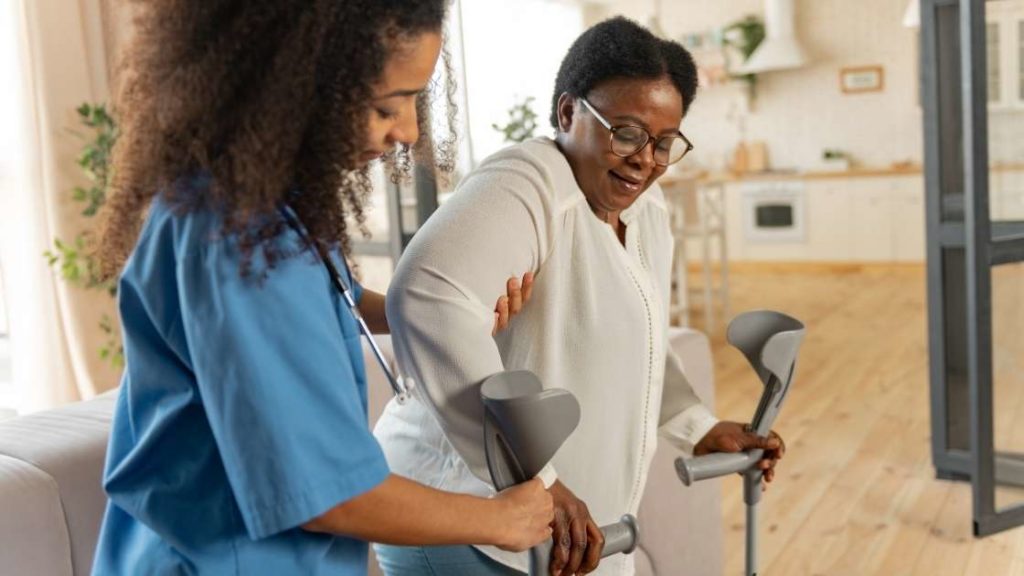Preventing Falls and Related Injuries

Even if a person isn’t physically injured, a fall can be distressing and lead to chronic anxiety around falling. Withdrawal from activities, as well as a lost sense of independence, are some of the less talked about symptoms of a fall.
Fortunately, there are ways to prevent falls, related injuries, and the fear of falling again. While these suggestions may be most helpful for older adults or those with aging parents, it’s never too early to add these preventive health measures to your life.
Tips for Fall Prevention
Improve balance and leg strength
- There’s a reason why I listed this one first. It’s best to strengthen your legs and balance long before you’re at risk for a serious fall injury. Yes, it’s still possible to start strengthening and balance-focused exercises when you’re over 65 — it’s never too late to start working out! But you’ll already be a few steps ahead if you enter senior status with great strength and balance. These two aspects of fitness allow for safer and more effective functioning, and they also make it easier to step over and around obstacles.
- While we’re on the topic, take a look at this strength article and this balance article for a deeper look into why cultivating these are so vital to injury prevention.
Fall Proof the Home
- Clear pathways and remove all trip hazards. Some of the most hazardous objects include extension cords
- Attach fall-grippers to throw rugs. Or consider throwing out the throw rugs altogether.
- Make sure the house is well-lit. Vision problems are a common cause of falls.
- Install handrails and non-skid treads on stairs.
- Use non-slip mats inside the shower and on the bathroom floor.
- Consider blocking off staircases with a gate, especially if you’re a caregiver for a person with dementia.
Wear Non-Slip Shoes
- Avoid flip flops, backless slippers, or any shoes with a poor grip.
- See a podiatrist and find out if orthotic inserts are right for you. Even if you don’t need orthotics, they’ll recommend the best type of shoe for your uniquely-shaped foot.
Eat Healthily
- Yes, nutrition does play a role in fall prevention. Both hypertension and hypotension can cause issues that put one at risk; shortness of breath during physical activity, lightheadedness when standing up, etc. Eat heart-healthy foods whole grains and leafy greens. Try to limit the donuts to special occasions.
Reduce Stress and Improve Your Mood
- There’s nothing to be ashamed of if you’re struggling emotionally. We all go through rough times, and some of us have chronic mood problems. Emotional pain by itself is burdensome, but it can also lead to issues that put one at risk for physical injury. Prolonged depression and stress are linked to poor sleep, low energy, inability to concentrate, unhealthy eating habits, substance abuse, headaches, lightheadedness, and a host of medical problems that each of these symptoms can cause. Any one of these side effects can lead to both emotional and physical collapse, so be careful and don’t ignore emotional distress.
- Take time for self-care. Do breathing exercises. Don’t feel guilty for taking breaks. Call and friend and say
Fall Prevention is Key
Take a look at your health regimen, your home’s layout, your footwear, and your overall sense of well-being. With a healthy mind, a balanced body, and a cleared walkway, you’re doing your preventive care right! Keep your legs strong and injury risk low.

Katrina Jenkins
Author, Licensed Massage Therapist
Katrina Jenkins graduated from Towson University in 2013 with a Bachelor’s Degree in Health Science and worked as a nurse’s aide briefly before pursuing her true passion. She graduated from the Massage Therapy Institute of Colorado in April 2016 with honors and completed the Touch of Healers Scholarship Program the following summer. She has been a part of the Moyer Total Wellness Team since the summer of 2017.
Resources
CDC. “Keep on Your Feet.” Centers for Disease Control and Prevention, 19 Dec. 2019, www.cdc.gov/injury/features/older-adult-falls/index.html.
Iaboni, Andrea, and Alastair J. Flint. “The Complex Interplay of Depression and Falls in Older Adults: A Clinical Review.” The American Journal of Geriatric Psychiatry, vol. 21, no. 5, May 2013, pp. 484–492, www.ncbi.nlm.nih.gov/pmc/articles/PMC4880473/, 10.1016/j.jagp.2013.01.008.
“Mood Disorders.” Johns Hopkins Medicine Health Library, 2019, www.hopkinsmedicine.org/health/conditions-and-diseases/mood-disorders.
“Preventing Falls and Related Fractures | NIH Osteoporosis and Related Bone Diseases National Resource Center.” Nih.gov, Dec. 2018, www.bones.nih.gov/health-info/bone/osteoporosis/fracture/preventing-falls-and-related-fractures.
Photo Credit
Canva by Zinkevych
